The speaking quietude • Less becomes more within the delicate grooves of the Be Good Tanyas' music
Copy from article in No depression
No Depression has been serving the Americana, alt-country and roots music community since 1995.
Some musicians play so loud, so fast, so hard
that they test the boundaries between music and noise. The clumsy ones
lose control and collapse into incoherence, but the agile ones — say,
the Velvet Underground, Hüsker Dü, R.L. Burnside and late Coltrane —
constantly threaten that collapse without ever allowing it, and with
that tension create great drama.
Something similar happens at the opposite end of the sonic spectrum.
One can play so quietly, so slowly, so delicately that the music
threatens to evaporate into nothingness. We don’t tend to think of this
subdued sound as being bold and innovative, but in fact these artists
create as much tension as the wall-shaking, roof-rattling
avant-gardists.
Of course, minimalism can be done badly and become merely boring,
but musicians such as Jonathan Richman, Olu Dara, Philip Glass and Kate
& Anna McGarrigle push at the boundary between understatement and
non-statement without ever crossing it. In doing so, they forge a sonic
tension that’s easily linked to the emotional tensions of our lives;
after all, our deepest secrets first emerge not in shouts, but in
whispers.
No one is pursuing this minimalism with more courage and success
right now than the Be Good Tanyas. These three women from Vancouver,
aged 27-31, revive old-time blues and hillbilly tunes and write new
songs in the same ancient mode, but they strip things down till the
music threatens to fall apart, although it never does.
This is not the easy minimalism of a single voice and a single
guitar; this is the riskier, more difficult minimalism of a full string
band with three-part vocal harmonies. The women — Samantha Parton,
Frazey Ford and Trish Klein — all sing, all play an assortment of
guitars, mandolins, banjos, harmonicas and ukuleles, and are usually
joined by a drummer and bassist. What’s thrilling about their 2000 debut
album Blue Horse and their follow-up disc Chinatown (due March 11 on
Nettwerk America) is the way they can get so much going in a song and
yet still keep things so quiet.
During a recent show at northern Virginia’s Iota Cafe, for example,
the Be Good Tanyas tackled “In My Time Of Dying”, the old blues-gospel
song that had been recorded as a driving, acoustic number by Bob Dylan
on his debut album and as a grandiose, amplified production by Led
Zeppelin on Physical Graffiti. The Tanyas took it in quite a different
direction, transforming it from a defiant protest against death into a
trembling contemplation of the inevitable.
Ford, wearing a floor-length, antique black gown and a big white
camellia over her right ear, played a reluctant swing rhythm on her
acoustic guitar. This was countered by slow, melodic banjo triplets from
Klein, a small redhead who allowed the bibs of her overalls to hang
downward from her waist. Chopping away at the swing pulse on mandolin
was Parton, the tallest member, whose bushy dark hair sprawled over the
collar of a thrift-shop, flower-print blouse. Ike Eidsness, the band’s
unofficial fourth member, softly brushed the drums.
Everything was done very quietly, very simply — but still there was a
gnawing tension in the way the swing chords pulled one way and the
banjo triplets pulled in another. Ford exploited that tension in her
vocal, a breathy, slightly nasal soprano that wasn’t shouting out to the
whole world, as Dylan and Robert Plant had, but was instead murmuring
to the person next to her. “Well, in my time of dying,” she sang, “I
don’t want nobody to mourn.”
It was as if the song’s protagonist were planning her own funeral,
and she was holding up well under the circumstances, but you could tell
from the frail voice and tentative arrangement that her composure could
crumble at any moment. “All I want my friends to do is to take my body
home,” Ford sang. And Parton and Klein answered her, “Well, well, well,”
in a deadpan whisper, as if agreeing to the request but without
pretending the task would be easy or pleasant.
This version of “In My Time Of Dying” is on the new CD, Chinatown,
and so is “Rowdy Blues”, another traditional number that is anything but
rowdy. When Ford sings, “I ain’t gonna marry, neither settle down,”
it’s not as a taunting boast but as an under-the-breath promise to
herself. There’s something unnerving about an act of social defiance
delivered so quietly, so calmly, especially when echoed by the whispery
harmonies and patient picking of her bandmates.
“That song has a delicate groove,” Ford explains. The phrase,
“delicate groove,” sounds like an oxymoron, but it gets at the heart of
the Be Good Tanyas sound. For there is a definite pulse, an inexorable
momentum to their arrangements, and the fact that it’s generated so
unassumingly makes it all the more strange and compelling.
“It’s a delicate groove in the sense that if you were to mess with
it, it would fall apart,” Ford elaborates. “The rhythm and the
counter-rhythm have to be balanced at the same volume and intensity. If
someone came in and emphasized one beat or the other, it would go out of
balance, and you’d lose the groove. On a lot of old blues records, the
rhythm of the vocal is offset by the rhythm of the guitar. We’re trying
to do the same thing with a whole band.”
“We were playing ‘Rowdy Blues’ at a festival workshop once,” Klein
recalls, “and one of the other performers onstage started wanking away
on his guitar, trying to turn it into a bar-band blues. I’m playing this
quiet banjo part, and he’s going ‘brwang-brwang.’ Afterwards, he said,
‘That’s the most delicate blues I’ve ever heard.’ I said, ‘That’s the
whole point.’”
“Our whole sound comes from sitting around in living rooms and
singing and playing with our friends, drinking tea and red wine,” Parton
points out. “If you really care about what you’re playing and the other
person cares about what you’re playing, you don’t have to be loud. In
fact, it’s better if you’re quiet.
“When we’re arranging songs, we try to take the best moments of
those living-room situations and preserve them. We’re always conscious
of not putting so much into a song that there’s no room for the emotion.
When other people are playing so much over your vocal that you can’t
breathe, you have to pull back.”
With their vintage clothes, acoustic instruments, old-time songs and
breathy harmonies, the Be Good Tanyas can seem like the ultimate
traditionalists. In fact, however, they see their music as fiercely
alternative, a natural outgrowth of the punk, funk and hip-hop music
they had championed in their younger days — and which they remain fans
of even now.
After all, if you wanted to create the antithesis of today’s
commercial radio — and it wouldn’t matter if the station were country,
pop, rock, urban or adult contemporary — it would be hard to find a more
radical departure than a whispery version of “In My Time Of Dying”.
“When I first heard bands like No Means No, GBH, X, the Accused and
Fugazi,” Klein remembers, “I realized that there was an alternative to
the radio.” She grew up in Winnipeg, out in the Canadian prairie. Her
family wasn’t very musical, and she was just a typical bored kid hanging
out at the mall until she discovered punk.
“These were bands that played with intensity and passion. The radio
bands played in these big arenas where you couldn’t get close and
couldn’t afford the ticket anyway. These bands you could actually see
live in a club.
“Later I was basically homeless in Winnipeg, and I found myself
hanging out at the Blue Note Cafe, this folk coffeehouse that stayed
open till four in the morning. I became best friends with this girl
Carla who was also a dispossessed teenager but who was a hippie instead
of a punk. She got me to smoke grass and listen to these Bob Dylan and
Leonard Cohen records, and I realized folk and punk had a lot in common.
“They both talked about real things and real feelings from a very
subversive perspective. And it was easy to see the performers live. A
lot of punks and hippies hung out together, because we were all the
rejects. We had the same values and we couldn’t see the point of working
your whole life just to get a pension.”
“But in the hippie movement,” Ford interjects, “you weren’t allowed
to be angry, and in the punk movement you’re not allowed to be tender.
Both of those are fucked up. That’s why I was drawn to old country and
blues tunes, because it allowed you to be both. If you’re looking for
alternatives in music, you’re going to be drawn to those old songs,
because it’s some of the best music out there.”
“I was looking for alternatives,” Klein continues, “and the first
alternative community I encountered was punk, but a lot of them were
self-destructive. The second alternative community was folk, which was
more nurturing. Today I know a lot of punks who are totally healthy
vegans, but the ones I knew back then were selling everything they owned
by buy crystal meth.
“In any case, I realized you didn’t have to be loud to be intense.
You could sit with one guitar and sing with deep feeling and be more
intense than a guy with a stack of Marshalls.”
Ford grew up in Vancouver, the daughter of an American draft dodger
and his wife. “As a kid, I was obsessed with Motown and Otis,” she says,
“and that’s still my main love. But my mom was always singing Emmylou
Harris songs when she did housework. That’s the music she used to
express herself. And even when I was in a trip-hop band, I realized that
the music I used for expressing my truest feelings was my mother’s
music. I tried to get as far away from country as I could, but I kept
coming back to it.”
Parton, too, grew up in Vancouver, but hers was a more conventional
childhood of classical piano lessons. “I loved Dolly Parton as a child
because we had the same last name,” she admits. “I went through a
punk-rock phase like everyone else, but I came back to folk and country.
For one thing, my twin sister and I liked to sing together, and country
music lends itself to harmony.
“For another, I had a high school boyfriend who played mandolin and
banjo. I had heard of Bob Dylan and Arlo Guthrie, but I had never heard
of Woody Guthrie till Gregg played me ‘Hobo’s Lullaby’. I was so struck
by it that I wanted to become a hobo. And, for a while, I did.”
That hobo life led her to the Kootenay Mountains on the eastern edge
of British Columbia in the early ’90s. For years the lumber companies
have hired seasonal labor to re-seed clear-cut areas there. For the
bohemian communities of Vancouver — punks and politicos as well as
hippies — tree planting is an attractive proposition. You can work
outside in the wilderness during the short Canadian summer and earn
enough money, when combined with unemployment benefits, to support
yourself the other eight months. Which leaves plenty of free time for
music, writing, politics, art, travel or whatever.
So it was that Parton found herself waking up in a nylon tent at the
crack of dawn one morning in the Kootenays. She grabbed three
saddlebags, each holding hundreds of tiny seedlings, and climbed aboard
the truck that took the crew high up on the slopes. Up on “the block,”
as they called the clear cut, the view was spectacular; you could gaze
out over miles and miles of sharply folded landscape, blanketed with
dark green pines and buttoned with glacial lakes.
But the work was back-breakingly hard and numbingly boring: You
knelt down, dug a hole, planted the seedling, stood up, scrambled
several yards sideways and repeated the process. Parton yearned for
something, anything, to break the tedium. So she was delighted to hear a
woman’s voice from further down the line of planters. It was a lilting
soprano warbling “I’d Rather Drink Muddy Water”, the old blues recorded
by Aretha Franklin, among others. Parton was so struck by the emotional
edge of the voice that she ambled across the steep slope to meet this
woman. It was Frazey Ford.
The two began spending their evenings together in the camp, a
collection of a few dozen tents encircling a central, canvas dining tent
and a big bonfire. It was around the fire that Parton and Ford
discovered how well they sang together on the old blues and country
songs they both liked.
“You’re working so hard and all you have is each other, so you form
these intense bonds,” Ford says. “You’re creating a new society in the
middle of nowhere. In the evenings, there’s nothing to do but sit around
the campfire, smoking pot, playing hackysack and singing songs. It’s a
great place to hear new music, because everyone comes from all over,
from the fringes of society, and they all bring boomboxes and
instruments.”
“There was so much music in those camps,” Parton recalls fondly.
“You could hear everything from Melanie to Liz Phair. But what impressed
me the most were the old songs by Woody Guthrie, Hank Williams and
Muddy Waters. It made me want to find the real roots of American music. I
wanted to hear harmonica; I wanted to hear banjos; I wanted to hear
women singing. So when the tree-planting season was over, I would get in
my van with my dog and guitar and head south, stopping at communes and
selling veggie burgers out of my van at festivals.”
Klein had her own brief brush with tree planting, but she met Ford
in a music class at Selkirk College in Nelson, a small bohemian town in
south-central British Columbia. Parton showed up around the same time,
and the three women realized they were learning more from the open-mike
nights at the S.U.B. Pub than they were from their college courses.
“I was in an acid-jazz-funk band called Fluid,” Ford recounts. “It
was fun — everybody was dancing — but so much was going on in the music
that I felt crowded out. So I decided to go in the opposite direction.
Rather than create a wall of sound, I wanted to create a rapport with
the audience. I know a loud band can convey emotion, too, but since I’m a
singer, I want to emphasize the voice. Plus, it’s more of a challenge
to convey something with the least resources. One old blues guy and a
guitar conveyed more than 90 percent of the music today.”
“Silence has always been a crucial part of my life,” Parton allows,
“silence, space and slowness. After those years of tree planting —
living in the bush with few clothes and few belongings — I never got
used to filling up my life again. The same thing is true of the band; we
still have the same handful of instruments that we started with.
Growing up in the ’70s and ’80s, we were inundated with wanking guitars
and screaming singers, but we learned that when you have one voice
that’s pure and beautiful and then you add a second voice, it opens the
door to a whole new world.”
“Playing with women gave me a safe place where I wouldn’t be
criticized,” Klein says, “where it was OK to be a beginner. With women I
didn’t feel I had to play a lot of fancy chops to prove myself; I could
experiment more and find my own sound. And it worked. I never tried to
play like Earl Scruggs; I never tried to fit that Appalachian style. I
just tried to complement Sam’s and Frazey’s voices.
“Now I have the confidence to play with anyone, but I still run into
situations where a guy shows up and starts adjusting the knobs on my
amp without asking, as if he were doing me a favor. I have to tell him,
‘What are you doing? Don’t do that.’”
It took a while before the Be Good Tanyas came to be, though. Ford,
who had been in a trip-hop band in Montreal, was in Saltwater Jane, an
all-female soul sextet, with Klein. Parton had toured with punk-poet
Chris Chandler as the Illegitimate Daughters of Johnny Cash. But none of
these ventures felt as vital as the informal music they were making in
living rooms. Nothing else inspired their songwriting as much as the
wish to bring something new to the next session.
In the summer of 1999, after they had all returned to Vancouver from
various journeys, Klein, Parton and Parton’s friend Jolie Holland
started performing as a trio called the Be Good Tanyas, named after a
song written by their friend Obo Martin. Whenever she was visiting
Klein’s Chinatown house, Ford would sing harmony with the group.
Their first gig was at a thrift store. “This crazy Turkish lady said
if we’d play in front of her vintage clothing store every Sunday, she’d
set up a sound system and pay us in clothes,” Parton explains. “We’d do
everything we knew or barely knew — Libba Cotten, Bessie Smith, Woody
Guthrie, songs by friends of ours, our own songs. We were like a
hillbilly garage band at first, very jangly and always on the verge of
falling apart.”
They had cut about a third of their first album by the spring of
2000, when Parton convinced the other three to go on tour as the opening
act for Bill Bourne, an older, bluesy, Canadian singer-songwriter.
“It was an insane, six-week tour that went from Winnipeg to the
Midwest to Texas to New Orleans,” says Ford, shaking her head. “We were
making these long drives through ice storms in this wobbly van. It was
incredibly stressful, and Jolie left the band over it. But it bonded the
three of us together, and we went back to Vancouver, finished the
record and released it on our own label, Porch Music.”
Holland contributed songwriting, arrangements, vocals and fiddle to
the first Be Good Tanyas album, Blue Horse, and she also sings harmonies
on Chinatown. She now lives in San Francisco, where she is working on a
solo album, with help from Parton.
Canada’s CBC radio network started playing Blue Horse frequently in
2000, and eventually the prominent Canadian indie label Nettwerk
licensed the album. That led to distribution in the U.S., England and
Australia, and enthusiastic reviews and tours in all three nations.
(Touring behind Chinatown will be limited, as NAME HERE is due to give
birth to a child this spring.)
When I saw their performances at the February 2002 Folk Alliance
conference in Jacksonville, Florida, and at the September 2002 Americana
Music Association conference in Nashville, the trio was already playing
most of the material on their second release, Chinatown. That album was
recorded in bits and pieces between tours, and it sounds very much like
their live shows and their debut disc.
“This is a natural extension of the first album,” Klein
acknowledges, “but it broadens the focus a bit. This one has more gospel
and blues on it, so we can showcase Frazey’s background as a soul
singer. It has Olu Dara playing trumpet on a few cuts. ‘Horses’ [the
next-to-last of the album's fourteen tracks] is almost like ambient
music. And the songwriting is more ambitious.”
Indeed, the originals by Ford and Parton stand up well next to tunes
such as Townes Van Zandt’s “Waiting Around To Die”, Peter Rowan’s
“Midnight Moonlight”, and the traditional ballad “I Wish My Baby Was
Born”, which Uncle Tupelo recorded on the March 16-20, 1992 album.
Parton’s “Dogsong 2″, for example, is the straightforward
description of the burial of her beloved dog Sherpa. Despite the subject
matter, it maintains a surprising dignity, never asking for pity, never
wishing away the facts of the matter. Parton’s deadpan, whispery vocal
and Elizabethan language (”There he sleeps where moss does creep and no
longer is he with me”) is framed by Klein’s slow-motion slide-guitar
phrases, Doug Thordarson’s deep-throated viola and Parton’s own
music-box-like ukulele figure. It’s a sequel to the first album’s
“Dogsong”.
“The first ‘Dogsong’ is really a love song to my former self,”
Parton confesses. “For years I was a free spirit and a vagabond
traveler, and my dog was my primary relationship during that time. But
there came a time when I had to stop traveling, move back to Vancouver
and get a job. I was living in this depressing neighborhood where I had
to walk past all these industrial shops to take my dog to the park. I
felt like a part of me was dying that winter.
“I had a dream that winter about all these dogs in the park who were
haunted by wishes for things they couldn’t have. Like there were dogs
with short legs who wanted to run fast, and there were small dogs who
wanted to be big. When I woke up the next morning, I started singing
that song. I realized I couldn’t stay young forever. You can’t escape
your past, but you can’t escape your future either. Time rolls on and
before you know it, your dreams have changed.”
Equally impressive is Ford’s “In Spite Of All The Damage”, a song of
fascinating contradictions. Over an acoustic guitar part that seems to
falter in every attempt at momentum, she sings, “I wanted to say to you
that I wanted to see your face again, that I wanted to hear you laugh…in
spite of all the damage I’ve done.” She’s willing to accept the blame
for deserting her former lover, but she knows that guilt doesn’t cancel
out desire. Not even the realization that the relationship will never
work can dampen her instinct.
So she confesses it all in a tentative soprano, pulled one way by
regret and the other way by affection. That tension is reinforced by her
stop-and-go acoustic guitar, Parton’s piercing mandolin, and Klein’s
yearning guitar fills. It’s a song full of conflict, but it needs to be
quiet, for these are admissions that can only be made in hushed voices.
By the time Klein added a mournful harmonica coda during their
performance of the song at the Iota Cafe, all three women had their eyes
closed — lost in the narrow space between private and public, swaying
to the delicate groove.
ND contributing editor Geoffrey Himes recently won an
ASCAP/Deems Taylor Award for his Baltimore City Paper article on Cyrus
Chestnut and his No Depression cover story on Rodney Crowell.

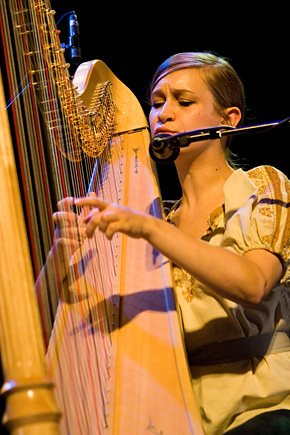 Harpspeelster en singer-songwriter Joanna Newsom -
vaak krijgt ze het ietwat cryptische predikaat avant-harpiste mee -
speelt op de door Jeff Mangum gecureerde editie van All Tomorrow's
Parties. De AB kan haar overhalen dit concert ook in Brussel te brengen.
Wegens het exclusieve karakter van de show zijn de tickets eerder aan
de dure kant, een mogelijke verklaring voor het feit dat het niet is
uitverkocht. Want iedereen die haar ooit live zag, weet dat ze nooit
teleurstelt. En dit is ook vanavond het geval. De afwezigen hebben
ongelijk.
Harpspeelster en singer-songwriter Joanna Newsom -
vaak krijgt ze het ietwat cryptische predikaat avant-harpiste mee -
speelt op de door Jeff Mangum gecureerde editie van All Tomorrow's
Parties. De AB kan haar overhalen dit concert ook in Brussel te brengen.
Wegens het exclusieve karakter van de show zijn de tickets eerder aan
de dure kant, een mogelijke verklaring voor het feit dat het niet is
uitverkocht. Want iedereen die haar ooit live zag, weet dat ze nooit
teleurstelt. En dit is ook vanavond het geval. De afwezigen hebben
ongelijk.
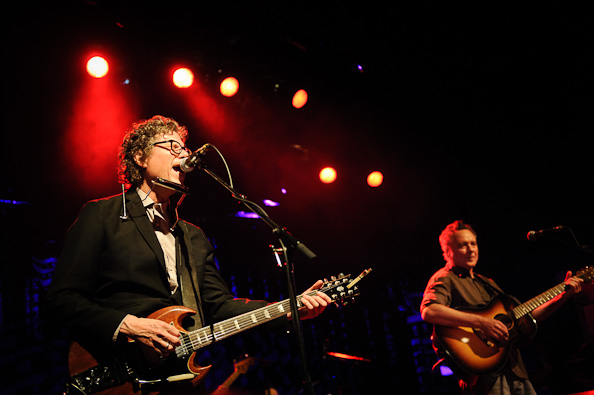
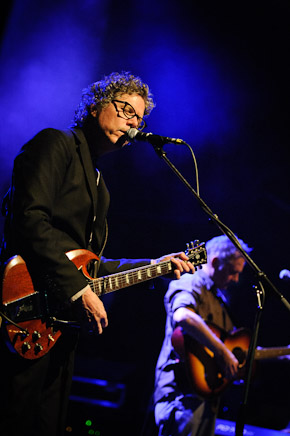
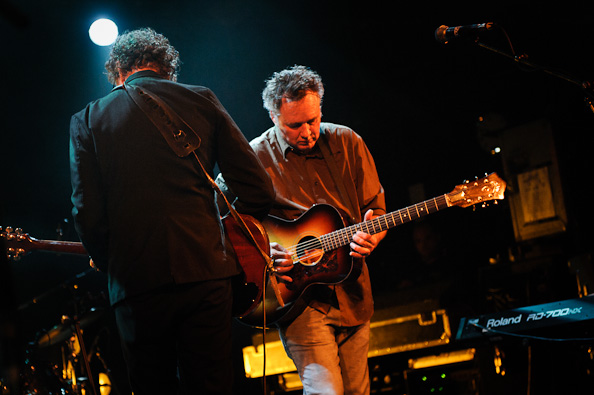
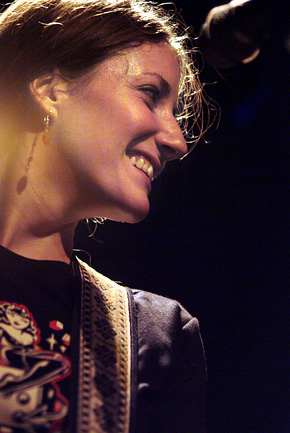 "Wat een vrouw, hè?" Een man - wit-grijs haar, biertje
in de hand - slaat een arm om de schouder van de man naast hem. Die
zucht instemmend: "Ja, wat een vrouw."
"Wat een vrouw, hè?" Een man - wit-grijs haar, biertje
in de hand - slaat een arm om de schouder van de man naast hem. Die
zucht instemmend: "Ja, wat een vrouw."